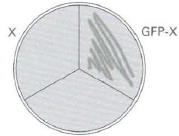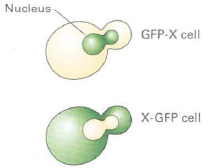A culture of yeast that requires uracil for growth (urα3ÍË was mutagenized, and two mutant colonies, X
Question:

a. What can be deduced about mutants X and Y from the data provided?
b. A wild-type yeast eDNA library, prepared in a plasmid that contains the wild-type URA3+ gene, is used to transform X cells, which are then cultured as indicated. Each black spot below represents a single clone growing on a petri plate. What are the molecular differences between the clones growing on the two plates? How can these results be used to identify the plasmid that contains a wild-type copy of gene X? Based on these results, how can the identity of gene X be uncovered?

Growth at 23 oC on media lacking uracil

Growth at 32 oC on media lacking uracil
c. DNA is extracted from the parental cells, from X cells, and from Y cells. PCR primers are used to amplify the gene encoding X in both the parental and the X cells. The primers are complementary to regions of DNA just external to the gene encoding X. The PCR results are shown in the gel at the right. What can be deduced about the mutation in the X gene from these data?

Southern

Parental X PCR
d. A construct of the wild-type gene X is engineered to encode a fusion protein in which green fluorescent protein (GFP) is present at the N-terminus (GFP-X) or the C-terminus (X-GFP) of protein X. Both constructs, present on a URA3+ plasmid, are used to transform X cells grown in the absence of uracil. The transformants are then monitored for growth at 32 °C, shown below at the left. At the right are typical fluorescent images of X-GFP and GFP-X cells grown at 23 oC in which green denotes the presence of green fluorescent protein. What is a reasonable explanation for growth of GFP-X but not X-GFP cells at 32 °C?

X-GFP
Growth at 32oC

GFP localization in cells grown at 23 oC
e. Haploid offspring of the diploid cells from part (a) above are generated. XY double mutants constitute 1/4 of these offspring. Haploid X cells, Y cells, and XY cells in liquid culture are synchronized at a stage just prior to budding and then are shifted from 23 oC to 32 oC. Examination of the cells 24 hours later reveals that X cells are arrested with small buds, Y cells are arrested with large buds, and XY cells are arrested with small buds. What is the relationship between X and Y?
Step by Step Answer:

Molecular Cell Biology
ISBN: 978-1429234139
7th edition
Authors: Harvey Lodish, Arnold Berk, Chris A. Kaiser, Monty Krieger, Anthony Bretscher, Hidde Ploegh, Angelika Amon, Matthew P. Scott





